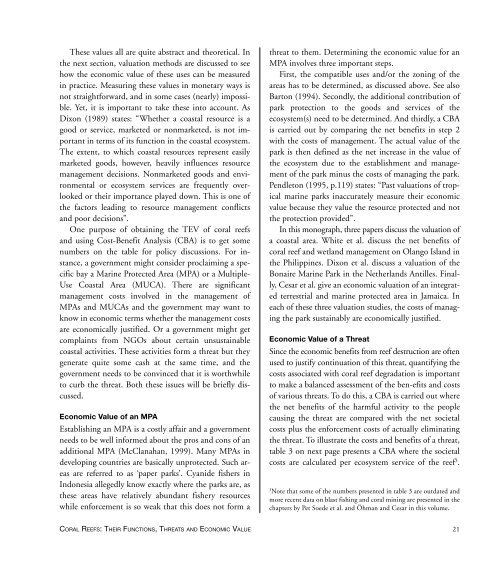You also want an ePaper? Increase the reach of your titles
YUMPU automatically turns print PDFs into web optimized ePapers that Google loves.
These values all are quite abstract and theoretical. In<br />
the next section, valuation methods are discussed to see<br />
how the economic value <strong>of</strong> these uses can be measured<br />
in practice. Measuring these values in monetary ways is<br />
not straightforward, and in some cases (nearly) impossible.<br />
Yet, it is important to take these into account. As<br />
Dixon (1989) states: “Whether a coastal resource is a<br />
good or service, marketed or nonmarketed, is not important<br />
in terms <strong>of</strong> its function in the coastal ecosystem.<br />
The extent, to which coastal resources represent easily<br />
marketed goods, however, heavily influences resource<br />
management decisions. Nonmarketed goods and environmental<br />
or ecosystem services are frequently overlooked<br />
or their importance played down. This is one <strong>of</strong><br />
the factors leading to resource management conflicts<br />
and poor decisions”.<br />
One purpose <strong>of</strong> obtaining the TEV <strong>of</strong> coral reefs<br />
and using Cost-Benefit Analysis (CBA) is to get some<br />
numbers on the table for policy discussions. For instance,<br />
a government might consider proclaiming a specific<br />
bay a Marine Protected Area (MPA) or a Multiple-<br />
Use Coastal Area (MUCA). There are significant<br />
management costs involved in the management <strong>of</strong><br />
MPAs and MUCAs and the government may want to<br />
know in economic terms whether the management costs<br />
are economically justified. Or a government might get<br />
complaints from NGOs about certain unsustainable<br />
coastal activities. These activities form a threat but they<br />
generate quite some cash at the same time, and the<br />
government needs to be convinced that it is worthwhile<br />
to curb the threat. Both these issues will be briefly discussed.<br />
Economic Value <strong>of</strong> an MPA<br />
Establishing an MPA is a costly affair and a government<br />
needs to be well informed about the pros and cons <strong>of</strong> an<br />
additional MPA (McClanahan, 1999). Many MPAs in<br />
developing countries are basically unprotected. Such areas<br />
are referred to as ‘paper parks’. Cyanide fishers in<br />
Indonesia allegedly know exactly where the parks are, as<br />
these areas have relatively abundant fishery resources<br />
while enforcement is so weak that this does not form a<br />
threat to them. Determining the economic value for an<br />
MPA involves three important steps.<br />
First, the compatible uses and/or the zoning <strong>of</strong> the<br />
areas has to be determined, as discussed above. See also<br />
Barton (1994). Secondly, the additional contribution <strong>of</strong><br />
park protection to the goods and services <strong>of</strong> the<br />
ecosystem(s) need to be determined. And thirdly, a CBA<br />
is carried out by comparing the net benefits in step 2<br />
with the costs <strong>of</strong> management. The actual value <strong>of</strong> the<br />
park is then defined as the net increase in the value <strong>of</strong><br />
the ecosystem due to the establishment and management<br />
<strong>of</strong> the park minus the costs <strong>of</strong> managing the park.<br />
Pendleton (1995, p.119) states: “Past valuations <strong>of</strong> tropical<br />
marine parks inaccurately measure their economic<br />
value because they value the resource protected and not<br />
the protection provided”.<br />
In this monograph, three papers discuss the valuation <strong>of</strong><br />
a coastal area. White et al. discuss the net benefits <strong>of</strong><br />
coral reef and wetland management on Olango Island in<br />
the Philippines. Dixon et al. discuss a valuation <strong>of</strong> the<br />
Bonaire Marine Park in the Netherlands Antilles. Finally,<br />
Cesar et al. give an economic valuation <strong>of</strong> an integrated<br />
terrestrial and marine protected area in Jamaica. In<br />
each <strong>of</strong> these three valuation studies, the costs <strong>of</strong> managing<br />
the park sustainably are economically justified.<br />
Economic Value <strong>of</strong> a Threat<br />
Since the economic benefits from reef destruction are <strong>of</strong>ten<br />
used to justify continuation <strong>of</strong> this threat, quantifying the<br />
costs associated with coral reef degradation is important<br />
to make a balanced assessment <strong>of</strong> the ben-efits and costs<br />
<strong>of</strong> various threats. To do this, a CBA is carried out where<br />
the net benefits <strong>of</strong> the harmful activity to the people<br />
causing the threat are compared with the net societal<br />
costs plus the enforcement costs <strong>of</strong> actually eliminating<br />
the threat. To illustrate the costs and benefits <strong>of</strong> a threat,<br />
table 3 on next page presents a CBA where the societal<br />
costs are calculated per ecosystem service <strong>of</strong> the reef 3 .<br />
3<br />
Note that some <strong>of</strong> the numbers presented in table 3 are outdated and<br />
more recent data on blast fishing and coral mining are presented in the<br />
chapters by Pet Soede et al. and Öhman and Cesar in this volume.<br />
CORAL REEFS: THEIR FUNCTIONS, THREATS AND ECONOMIC VALUE<br />
21


















